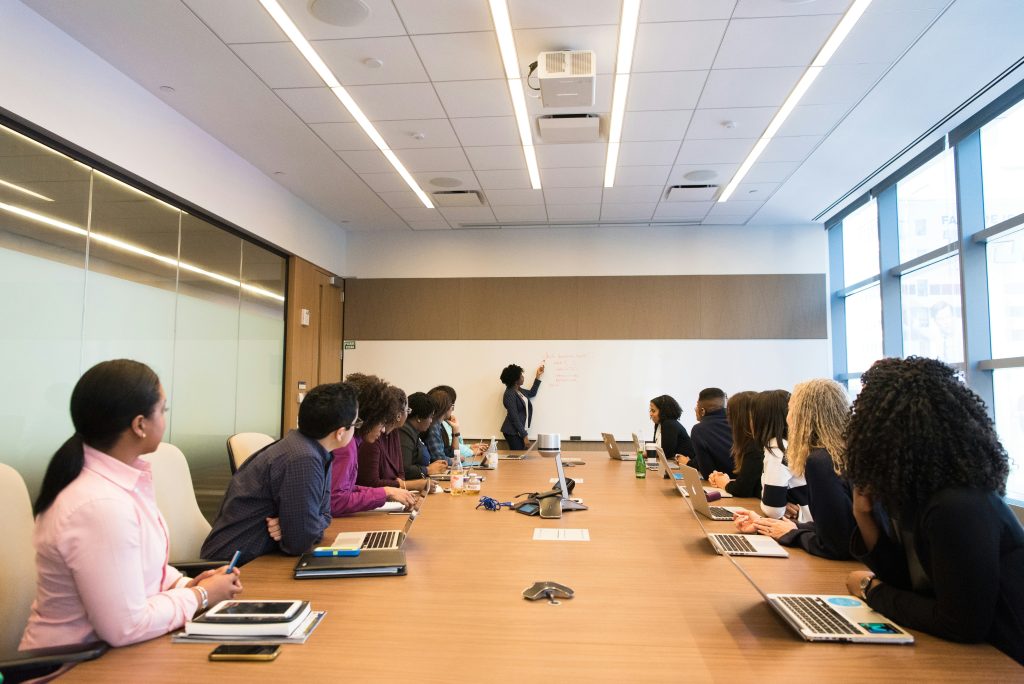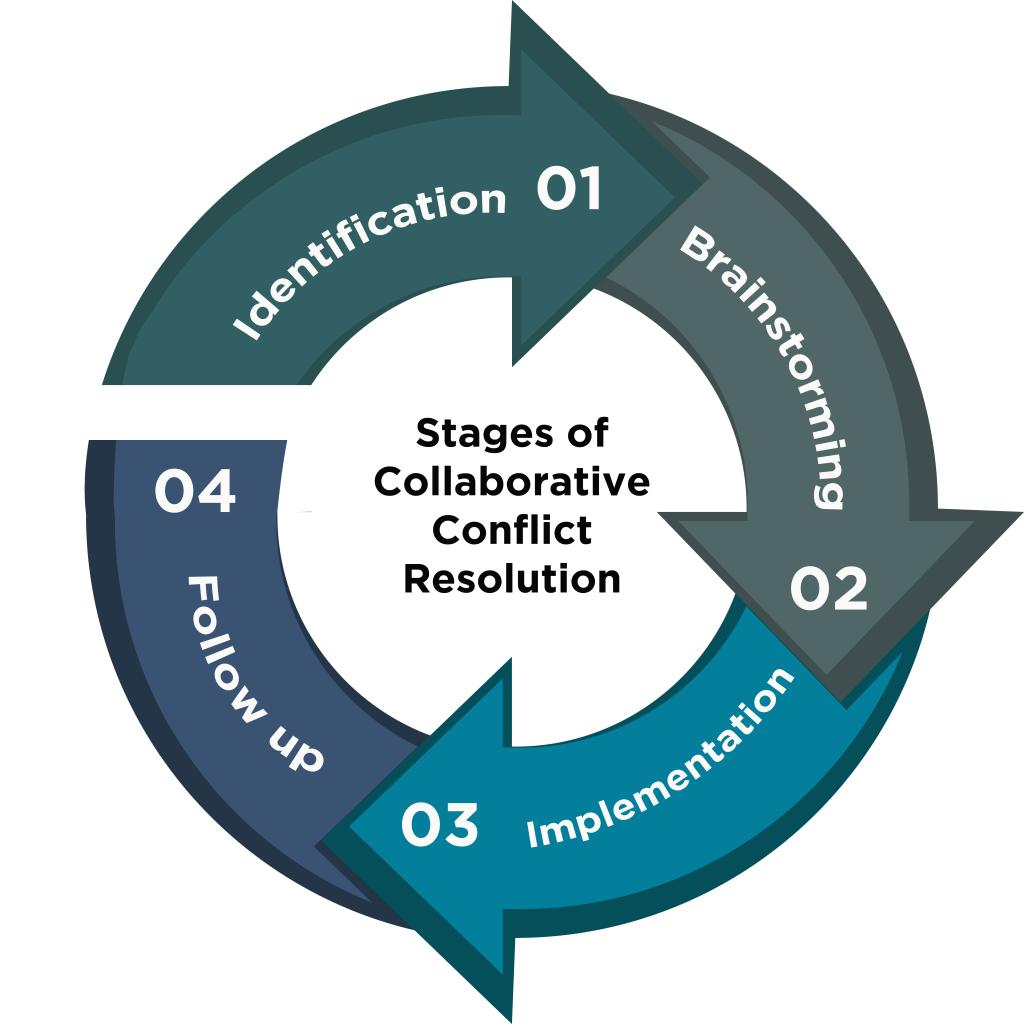3.2 The Lesson: Collaboration – Let’s Work Together

In Chapter 2, we studied Thomas-Kilmann’s five approaches to conflict resolution. One of the five approaches was collaboration. Whether you are assisting two employees or two groups of employees in resolving a workplace conflict, you are unlikely to say, “I want you to resolve your workplace conflict using a collaborative approach.” Instead, you will say, “Let’s find a way to work together.” In this chapter, we will focus on creating an environment conducive to collaborative conflict resolution.
Creating a Collaborative Environment
To resolve a conflict using collaboration, you must build and reinforce a culture and workplace that supports collaboration. If your workplace lacks overall cooperation, you can’t expect your employees to engage in collaborative conflict resolution.
What does a collaborative workplace look like?
Busy – there are employees visibly working together to solve problems
Structured – you might see meeting rules posted in meeting rooms
Organized – a well-documented plan in place
What does a collaborative workplace sound like?
Quiet – there are conversations rather than arguments
Professional – employees greet one another with respect
Diversified – there is an emphasis on gaining differing opinions
What does a collaborative workplace feel like?
Safe – employees are free to share their goals and opinions
Calm – employees don’t have to deal with toxic people or conversations
Welcoming – guests and new employees feel welcomed and included
Establishing the Ground Rules

Have you ever attended a meeting and there are ground rules? It is common for organizations to establish agreed-upon ground rules. These ground rules guide the meeting and the attendees. Let’s look at some common meeting rules.
Common Meeting Rules
- – Arrive at the meeting on time
- – No talking over other people
- – Appoint someone to take minutes
- – No working on your electronics during discussions
- – Stay on topic
While these common meeting rules are a great starting place, the list must be expanded when a meeting involves collaborative conflict resolution. Here are some rules a Human Resources professional might want to add to the rules.
Collaborative Meeting Rules
- – All brainstorming ideas are welcome
- – We encourage active participation by all
- – No shouting or swearing
- – No blaming others
- – Listen with an open mind
The Stages of Collaborative Conflict Resolution

Collaborative conflict resolution is a process. Let’s examine its steps in more detail.
Identification
As a Human Resources professional, you need to approach problem-solving and conflict resolution by identifying the real source of the issue. This first step can take time and may involve discussions with multiple employees to uncover the root cause of the issue. You will utilize skills such as active listening, and your goal is to understand the goals of the employees involved in the conflict. The identification phase requires time as there are several questions you need answered to move the process forward.
Brainstorming
Once you have a clear understanding of the root cause of the conflict and the goals of the individuals involved in the conflict, you should include these individuals in the solution. Here, you can emphasize that we are all “working together.” Brainstorming requires each individual to share ideas that might contribute to resolving the conflict. There should be no limit on the number of ideas generated and no comments to shut down an idea. Once all of the ideas have been gathered, a discussion should take place to agree upon a solution that makes sense for everyone involved.
Implementation
Now that you have an agreed-upon solution, it is time to implement a collaborative approach to the conflict. It is an excellent time to remind everyone involved that we are “working together” to solve the issue, as you need everyone to have an open mind and a desire to resolve the conflict. In the implementation stage, everyone will be assigned tasks and timelines. An example might be the need for an individual to apologize to another person for their behaviour, and they must issue the apology by tomorrow. Expectations and timelines must be clear and agreed upon. It is best to put an implementation plan in writing, as it will be revisited in the next phase of this process.
Follow-up
As the final step in the process, you must follow up with the individuals involved in the conflict. You are checking to see if things have improved and if anything that needs to be addressed is outstanding. If you find out the solution did not resolve the conflict, you must re-visit the possible solutions generated in your brainstorming session and change direction. The follow-up stage must continue until all the parties involved in the conflict agree they are satisfied with the solution.
Collaborative Language 
When we are involved in the collaborative conflict resolution process, it is helpful to understand the importance of the words we use in communicating with one another. Rather than making statements, it is best to ask questions.
Here are some examples of statements that have been turned into collaborative questions. The collaborative language ends with a question mark.
Statement: It seems like this is important to you.
Question: Why is this so important to you?
Statement: It is pretty clear what is happening here.
Question: Can you tell me what happened from your perspective?
Statement: We should focus on the cost to our business.
Question: What do you want to focus on?
Statement: I know exactly what you mean.
Question: Can you tell me what it has been like for you?
Statement: I think we should invite others to join us.
Question: Do we need to include anyone else in this conversation?
Chapter 3 Exercises

Exercise 1
- Statement: It looks like we are all finished here. Question:
- Statement: It doesn’t look like anyone witnessed this argument. Question:
- Statement: I can tell you are upset right now. Question:
Video: “Collaborative Conflict Management” by Professor Rockey [6:34] is licensed under the Standard YouTube License.Transcript and closed captions available on YouTube.
Exercise 2
Discussion – In your opinion, which of the collaborative conflict resolution steps highlighted in the above video are most valuable when you work as a Human Resources professional? Why?

